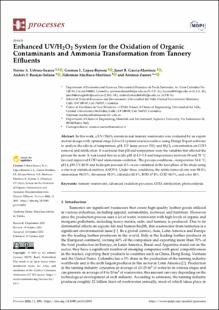In this work, a UV/H2O2 system in real tannery wastewater was evaluated by an experimental design with optimal stage 2-level I-optimal reaction surface using Design Expert software
to analyze the effects of temperature, pH, UV lamp power (W), and H2O2 concentration on COD
removal and nitrification. It was found that pH and temperature were the variables that affected the
process the most. It was found that an acidic pH of 4.5–5.5 and temperatures between 50 and 70 ◦C
favored improved COD and ammonium oxidation. The process conditions—temperature 54.6 ◦C,
pH 4, pW-UV 60 W and hydrogen peroxide 0.5—were confirmed in the next phase of the study using a one-way statistical analysis ANOVA. Under these conditions, the nitrite removal rate was 98.4%, ammonium 94.53%, chromium 92.3%, chlorides 62.4%, BOD 67.4%, COD 44.5%, and color 48%.



 PDF
PDF
 LEER EN FLIP
LEER EN FLIP













